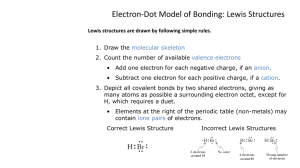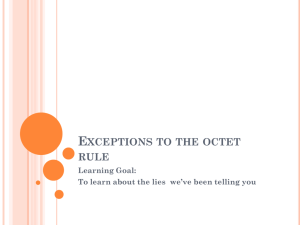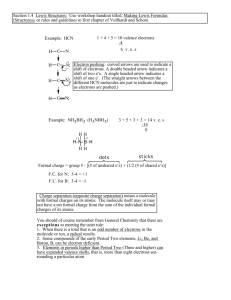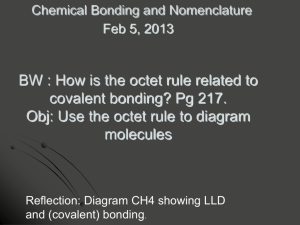Feb 4 bonding
advertisement
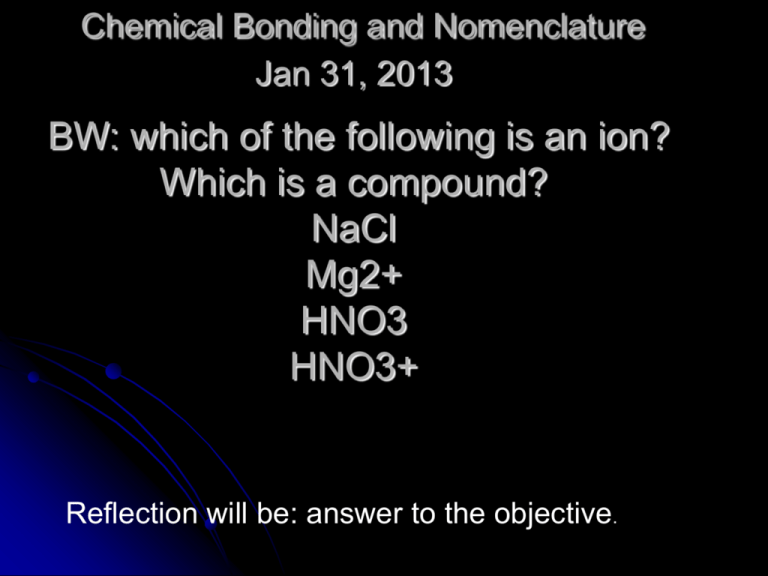
Chemical Bonding and Nomenclature Jan 31, 2013 BW: which of the following is an ion? Which is a compound? NaCl Mg2+ HNO3 HNO3+ Reflection will be: answer to the objective. Chemical Bonding and Nomenclature Jan 31, 2013 I’ll collect BW on Monday not today, not tomorrow. Tomorrow is computer lab day. Reflection will be: answer to the objective. Chemical Bonding and Nomenclature Obj: know the difference between an ion, a polyatomic ion, a compound, a chemical name, and a chemical formula. ACE THIS TEST Chemical Bonding and Nomenclature Ionic Compounds W/ a Transition Metal. Fe (III) Fe3+ Mg (IV) Mg 4+ Cu (II) Cu 2+ Chemical Bonding and Nomenclature The oxidation state of an element is related to the number of electrons that an atom loses, gains, or appears to use when joining with another atom in compounds. It also determines the ability of an atom to oxidize (to lose electrons) or to reduce (to gain electrons). Almost all of the transition metals have multiple potential oxidation states. i.e Fe, Cu, Au, Ag etc Some elements (transition metals) use roman numerals to specify their charge. Roman numeral Charge I +1 II +2 III +3 IV +4 V +5 VI +6 Chemical Bonding and Nomenclature Review Transition metals: Multiple-Charge Transition Metals Question Fe(2+) Fe(3+) Cu(1+) Cu(2+) Au(1+) Au(3+) Hg(1+) Hg(2+) Answer Iron(II) Iron(III) Copper(I) Copper(II) Gold(I) Gold(III) Mercury(I) Mercury(II) Mercury(II)common name Mercury(I)common name Iron(II) Iron(III) Copper(I) Copper(II) Gold(I) Gold(III) Mercuric Mercurous Ferrous Ferric Cuprous Cupric Aurous Auric Chemical Bonding and Nomenclature Common Names: Na2CO3 = sodium carbonate. ( This is a useful chemical in purifying others; it is sometimes called washing soda) KNO3 = potassium nitrate ( This is an ingredient of gunpowder and it is also found in fertilizer.) Chemical Bonding and Nomenclature Mercury(II)common name Mercury(I)common name Iron(II) Iron(III) Copper(I) Copper(II) Gold(I) Gold(III) Mercuric Mercurous Ferrous Ferric Cuprous Cupric Aurous Auric Chemical Bonding and Nomenclature the same rules apply, but you have to learn the names and charges of comm Polyatomic Ion Name OH-1 hydroxide SO4-2 sulfate PO4-3 phosphate NO3-1 nitrate CO3-2 carbonate HCO3-1 hydrogen carbonate or bicarbonate ClO3-1 chlorate NH4+1 ammonium I want you to meet a friend of mine? OBJ: Know the difference between the two, by drawing each. refer to Text: pages 212- 214) 8 Monday Feb 4 BW: What is the difference between a molecule and a compound? Reflection. Diagraming chemical molecules I want you to meet a friend of mine? Electronegativity: the degree to which an element can bond. I want you to meet a friend of mine? Draw a molecule, using circles for atoms Draw a compound, using circle for atoms draw a diatomic molecule Draw the molecular formula for C2H6 C2H6 8-2 Bonding I want you to meet a friend of mine? H2 is a diatomic molecule because; is has TWO atoms in its formula it is covalently bonded All molecules are covalently bonded. All must share electrons. Video. http://www.brightstorm.com/science/chemist ry/chemical-bonds/covalent-bonds/ I want you to meet a friend of mine? In drawing out; they appear 1. H—H Draw the bonding arrangement for Fluorine, a diatomic molecule; Start with the LDD lewis dot structure: then add the shared bonds. I want you to meet a friend of mine? 2. F ---F 3. H20 4. NH3 ammonia 5. Methane: CH4 6. BCl3 boron Trichloride I want you to meet a friend of mine? 7. HCl = Hydrogen chloride YOU DO THESE 8. H202 DihydrogenDioxide YOU DO THESE 8. H202 DihydrogenDioxide 9. PCl3 Phosphorus Trichloride I want you to meet a friend of mine? video http://www.youtube.com/watch?v=6_YhSLn AmVo electronegativity page…. electronegativity page 238 Can you predict bonding type? (discuss in your table) Can you predict Covalent? Ionic? Polar covalent? polar) I want(Or you to meet a friend of mine? polar http://www.youtube.com/watch?v=IBtCV12i2 BQ Double and Triple Bonds….. atoms form double or triple bond if they can form noble gas configuration. I want you to meet a friend of mine? 12. 02 Diatomic molecule - - - - > is a double bond. 13. N is a triple bond , also a diatomic molecule 14. C02 Carbon Dioxide is a double bond. 15. NF3 16. SB2 I want you to meet a friend of mine? 8.2c Exceptions to the Octet Rule Although many Lewis structures follow the octet rule, there are exceptions. Electron-deficient compounds are compounds in which an element has an incomplete octet. Some elements, notably H, Be, and B, often have fewer than eight electrons Lewis I wantinyou tostructures. meet a friend of mine? Hydrogen has a single valence electron in a 1s orbital and therefore accommodates only two electrons when it forms covalent bonds. Therefore, it almost always forms only one chemical bond to another atom and does not accommodate lone pairs of electrons. Beryllium electrons) boron I want(two youvalence to meet a friendand of mine? (three valence electrons) often accommodate only four or six electrons, respectively, in Lewis structures. For example, BF3 is an electron-deficient compound. Each fluorine has a complete octet (six nonbonding electrons plus two bonding electrons), but boron has only six electrons (six Ibonding electrons andano lone of pairs). want you to meet friend mine? Changing a fluorine lone pair to a bonding pair would alleviate the electron deficiency, but fluorine's high electron affinity means this element is unlikely to share its nonbonding electrons with boron. The electron deficiency means that BF3 is a highly reactive compound. For example, it reacts readily with NH3. In this reaction, the lone pair on N forms a new covalent bond between the I want you tonew meet a friend of mine? compounds. In the compound, both N and B have full octets and the neither compound is electron deficient. Free radicals are compounds with at least one unpaired electron. Free radicals can also be electron-deficient compounds. Nitrogen monoxide (nitric oxide, NO) is a free-radical compound because it is an oddI want you towith meet a friendelectrons of mine? electron molecule 11 valence and 1 unpaired electron. Notice that the unpaired electron is placed on the nitrogen atom. In general, the odd electron in free radicals is not located on oxygen because of its high electron affinity. Free radicals are highly reactive species because the unpaired electrons react with want you to meet a friend of mine? otherI molecules. Pure NO, for example, reacts readily with halogens, O2, and other free radicals. Elements with an expanded valence (also called an expanded octet) have more than 8 electrons (often 10 or 12) in a Lewis structure. Elements in the third period and below, such I want yousulfur, to meet friend of mine? as phosphorus, andabromine, often have an expanded valence because of their larger radii (when compared to the secondrow elements) and the availability of empty d orbitals in the valence shell. Consider the Lewis structure of SF4. Each fluorine has a satisfied octet (6 nonbonding electrons plus 2 bonding electrons), but the central sulfur atom has an expanded octet with 10 electrons around it (8 bonding electrons and 2 nonbonding I want you to meet a friend of mine? electrons). Example Problem: Draw Lewis Structures (Octet Rule Exceptions) Draw the Lewis structure for Example Problem: Draw Lewis Structures (Octet Rule Exceptions) Draw the Lewis structure for ClO IBr3 I want you to meet a friend of mine? You are asked to draw the Lewis structure for a molecule or ion with a central atom that can have an expanded valence. You are given the chemical formula for a molecule or ion. Step 1: 7 + 6 = 13 valence electrons (or 6 want you to meet a friend of mine? pairsI and 1 unpaired electron) This is an odd-electron molecule (a free radical). The unpaired electron is placed on chlorine because oxygen has a high electron affinity. Step 1: 7 + (3 × 7) = 28 valence electrons I want (or 14 pairs) you to meet a friend of mine? Steps 2 and 3: Iodine has a lower affinity for electrons that bromine, so it is the central atom. Steps 4 and 5: Iodine is in the fifth period and therefore can Step 1: 7 + (3 × 7) = 28 valence electrons (or 14 pairs) Steps 2 and 3: Iodine has a lower affinity for electrons that bromine, so it is the central atom. Steps 4 and 5: I want youfifth to period meet and a friend of mine? Iodine is in the therefore can have an expanded valence. exceptions to octet rule http://sowl.cengage.com/ebooks/vining_owlbook_p rototype/ebook/videos/VS_8_2_3.htm Can you predict bonding? BW> What is van del wahls forces (pg 240) read and answer. I want you to meet a friend of mine?


